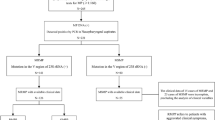Abstract
A prospective multicenter study involving 156 Japanese medical institutions was conducted to clarify the clinical features of adult atypical pneumonia and the efficacy and safety of clarithromycin. Atypical pneumonia was suspected in 730 patients according to the Japanese Respiratory Society’s Guidelines for the Management of Community-Acquired Pneumonia in Adults, and clarithromycin was administered. On the basis of bacteriological and serological tests, 465 patients were diagnosed with atypical pneumonia. Mycoplasma pneumonia was common among younger patients and chlamydia pneumonia among older patients. Underlying respiratory disease was uncommon among mycoplasma patients but prevalent among chlamydia patients. According to the severity classification given in the abovementioned guidelines, most mycoplasma patients had mild infection, whereas a high percentage of chlamydia patients had moderate infections. Body temperature was higher and coughing more severe in the mycoplasma patients than in the chlamydia patients. On the other hand, intergroup differences were not observed regarding extent of lung shadowing on plain radiographs, peripheral white blood cell count, or C-reactive protein (CRP). The effectiveness of clarithromycin was 96.8% in mycoplasma patients (153/158), 92.9% in chlamydia patients (78/84), and 96.0% in the group comprising all atypical pneumonia patients, including those with superinfection (288/300). The incidence of adverse drug reactions was 3.4% (24/698). Macrolide resistance in Mycoplasma pneumoniae has been reported in Japan, but the results of this surveillance study showed that clarithromycin is effective in treating adult atypical pneumonia.




Similar content being viewed by others
References
Kawai S, Ochi M, Nakagawa T, Goto H. Antimicrobial therapy in community-acquired pneumonia among emergency patients in a university hospital in Japan. J Infect Chemother. 2004;10:352–8.
Ishida T, Hashimoto T, Arita M, Tojo Y, Tachibana H, Jinnai M. A 3-years prospective study of a urinary antigen-detection test for Streptococcus pneumoniae in community-acquired pneumonia: utility and clinical impact on the reported etiology. J Infect Chemother. 2004;10:359–63.
Miyashita N, Fukano H, Mouri K, Fukuda M, Yoshida K, Kobayashi Y, et al. Community-acquired pneumonia in Japan: a prospective ambulatory and hospitalized patient study. J Med Microbiol. 2005;54:395–400.
Saito A, Kohno S, Matsushima T, Watanabe A, Oizumi K, Yamaguchi K, et al. Prospective multicenter study of the causative organisms of community-acquired pneumonia in adults in Japan. J Infect Chemother. 2006;12:63–9.
Matsuoka M, Narita M, Okazaki N, Ohya H, Yamazaki T, Ouchi K, et al. Characterization and molecular analysis of macrolide-resistant Mycoplasma pneumoniae clinical isolates obtained in Japan. Antimicrob Agents Chemother. 2004;48:4624–30.
Morozumi M, Hasegawa K, Kobayashi R, Inoue N, Iwata S, Kuroki H, et al. Emergence of macrolide-resistant Mycoplasma pneumoniae with a 23S rRNA gene mutation. Antimicrob Agents Chemother. 2005;49:2302–6.
Suzuki S, Yamazaki T, Narita M, Okazaki N, Suzuki I, Andoh T, et al. Clinical evaluation of macrolide-resistant Mycoplasma pneumoniae. Antimicrob Agents Chemother. 2006;50:709–12.
The Committee for the Guidelines in Management of Respiratory Infection, Japanese Respiratory Society. The Japanese Respiratory Society Guidelines for the Management of Community-Acquired Pneumonia in Adults. The Japanese Respiratory Society; 2005 (in Japanese).
Japanese Society of Chemotherapy. Respiratory Tract Committee, Protocol Composition Committee, and Clinical Trials Committee. Committee report: Clinical trial protocol for a new antimicrobial agent for the treatment of respiratory tract infections. J Infect Chemother. 2002;8:273–319.
Matthias FCB, Kristien D, Alje PD, Kate ET, Eric CJC, Herman G. Evaluation of 12 commercial tests and the complement fixation test for Mycoplasma pneumoniae-specific immunoglobulin G(IgG) and IgM antibodies, with PCR used as the “Gold standard”. J Clin Microbiol. 2005;43:2277–85.
Narita M. Utility and limitation of the rapid IgM antibody detection test for the diagnosis of Mycoplasma pneumoniae infection. Kansenshōgaku Zasshi 2007;81:2:149–54 (in Japanese).
Kishimoto T, Ando S, Numazaki K, Ouchi K, Yamazaki T, Nakahama C. Assay of Chlamydia pneumoniae-specific IgM antibodies by ELISA method-reduction of non-specific reaction and resetting of serological criteria by measuring IgM antibodies. Jpn J Infect Dis. 2009;62:260–4.
Miyashita N, Kawai Y, Yamaguchi T, Ouchi K, Kobayashi Y, Oka M. Evaluation of false-positive reaction with ELISA for the detection of Chlamydophila pneumoniae-specific IgM antibody in adults. Jpn J Infect Dis. 2010;63:150–1.
Miyashita N, Fukano H, Okimoto N, Hara H, Yoshida K, Niki Y, et al. Clinical presentation of community-acquired Chlamydia pneumoniae pneumonia in adults. Chest. 2002;121:1776–81.
Miyashita N, Saito A, Kohno S, Oizumi K, Yamaguchi K, Watanabe A, et al. Community-acquired Chlamydia pneumoniae pneumonia in Japan: a prospective multicenter community-acquired pneumonia study. Intern Med. 2002;41:943–9.
Miyashita N, Fukano H, Yoshida K, Niki Y, Matsushima T. Is it possible to distinguish between atypical pneumonia and bacterial pneumonia?: evaluation of the guidelines for community-acquired pneumonia in Japan. Respir Med. 2004;98:952–60.
Acknowledgments
We express our deepest gratitude to all physicians who collaborated with this surveillance study and provided valuable data.
Author information
Authors and Affiliations
Corresponding author
About this article
Cite this article
Goto, H. Multicenter surveillance of adult atypical pneumonia in Japan: its clinical features, and efficacy and safety of clarithromycin. J Infect Chemother 17, 97–104 (2011). https://doi.org/10.1007/s10156-010-0184-z
Received:
Accepted:
Published:
Issue Date:
DOI: https://doi.org/10.1007/s10156-010-0184-z




